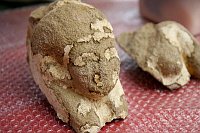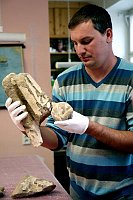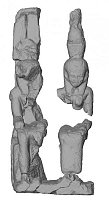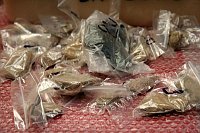Unas tareas de limpieza y conservación realizadas en Cerro Santuario, donde hace 42 años el profesor Francisco Presedo Velo, encontró la Dama de Baza, han sacado a la luz una estructura funeraria de una importancia tal que pude cambiar toda o gran parte de la información que hasta ahora se tenía sobre el mundo funerario ibero.
Según el arqueólogo Alejandro Caballero, que es el director de la excavaciones de urgencia que se están realizando en la necrópolis de Cerro Santuario, la nueva estructura funeraria ahora descubierta, cuya excavación aún no ha concluido, se corresponde con una cámara subterránea, con acceso mediante escaleras desde un nivel superior, donde se encuentra una puerta, rodeada por un banco adosado a las paredes. Toda la estructura está edificada con ladrillos de adobe, y en algunos puntos conserva el revestimiento original, consistente en una capa de cal pintada en color rojo, con motivos geométricos. Provisionalmente se considera que la cronología de uso de la misma se encuadra en los siglos V-IV a.C., dentro de la denominada “cultura ibérica”. El hallazgo de esta cámara supone un gran hito en la investigación de la necrópolis, puesto que nunca antes se había podido documentar la forma de acceso y el sistema de cubierta de los grandes enterramientos.
Otra de las novedades que aporta este enterramiento es la presencia de restos humanos, lo que tiene un tanto confundidos a los investigadores, pues en el mundo funerario de época ibera, los muertos se incineraban. La propia escultura de la Dama de Baza, albergada en una urna con las cenizas de una mujer joven de algo más de 30 años de edad. Ahora los antropólogos, intentan datar la edad de los restos humanos encontrados en la cámara funeraria que aun se está escavando. Hasta el momento se han encontrado restos de varios niños y de alguna persona adulta. El equipo de arqueólogos que dirige Alejando Caballero, es muy cauto y no quiere aventurar hipótesis porque, ni si quiera se ha terminado los trabajos de campo.
El hallazgo de la cámara funeraria y otros que se están localizando en la misma necrópolis, ponen en evidencia varias cuestiones, una es la imperiosa necesidad de acometer una excavación e investigación sistemática en Cerro Santuario, que estaba prevista y que se paralizo hace unos años por falta de presupuesto. Si antes no había dinero, ahora lo hay menos, por eso ayer la Delegada Territorial de Educación y Cultura, acudió a Baza para mantener una reunión de trabajo con el alcalde bastetano, Pedro Fernández Peñalver, para entre otros asuntos intentar buscar una vía de financiación y poder realizar una excavación sistemática, que 42 años después pueda poner orden en esta yacimiento, donde se han producido expoliaciones continuamente. Una de las formulas estudiadas podría ser la solicitud de un taller de empleo arqueológico, que aportaría la financiación suficiente para poder realizar una excavación potente, al menos durante un año. La delegada de Educación y Cultura, Ana Gámez, visito la necrópolis y la cámara funeraria
Otra de las cuestiones que plantea el hallazgo es también la necesidad que ya se venía pidiendo por los expertos de volver a reestudiar, catalogar e investigar todo el yacimiento, pues, cuando lo hizo Francisco Presedo Velo, la metodología era muy distinta a la de hoy en día y hay muchos errores en la publicación “ La Necrópolis de Baza” de Presedo Velo, editada por el Ministerio de Cultura 11 años después ( 1982) del descubrimiento de la Dama de Baza y de los últimos trabajos en la necrópolis que fueron financiados por el magnate catalán Pere Duran Farel, lo que de daba derecho a quedarse con determinadas piezas de al excavación y que conservan sus herederos en su museo particular. El resto de piezas importantes se encuentran en el Museo Arqueológico Nacional. En la publicación sobre las excavaciones realiza por Francisco Presedo Velo hay catalogadas 177 tumbas de diverso tamaño e importancia. Curiosamente junto a la tumba de la Dama de Baza, había una de un guerrero que contenía un importante ajuar funerario e incluso su carruaje, pero fue expoliada.
Plan de Fomento del Empleo Agrario
El Ayuntamiento de Baza decidió con muy buen criterio. pues de otyra manera no hubiera sido posible realizar ninguna limpieza y conservación, dedicar 114.000 euros del Plan de Fomento de Empleo Agrario para que desempleados del campo, bajo la dirección de un arqueólogo realizara trabajos de limpieza y conservación en los yacimientos arqueológicos del entorno de la antigua ciudad Ibero-romana de Basti. Se trata de un proyecto para la consolidación y mantenimiento de los yacimientos arqueológicos de Basti. 60.000 euros los aporta el Ministerio de Empleo y Seguridad Social para la contratación de los 60 peones y el técnico que dirige la intervención. 18.000 euros lo aporta la Junta de Andalucía por medio de la Consejería de Gobernación, 30.000 euros es la aportación municipal y 6.000 la Diputación de Granada.
Gracias a los trabajos de limpieza y conservación que duran ya casi dos meses, se ha podido hallar la cámara funeraria. Como es preceptivo el hallazgo se comunico a la Delegación Territorial de Educación y Cultura para que realizara una excavación de emergencia que es la que se está desarrollando en la actualidad, mientras continúan las trabajos de limpieza, conservación y protección del yacimiento de Cerro Santuario, que ahora ha sido vallado, a la vez que está siendo sometido a una intensa vigilancia por parte de las fuerzas de seguridad, el Seprona de la Guardia Civil, la Policía Local de Baza y la Policía Nacional.
Gracias a los trabajos de limpieza y conservación que duran ya casi dos meses, se ha podido hallar la cámara funeraria. Como es preceptivo el hallazgo se comunico a la Delegación Territorial de Educación y Cultura para que realizara una excavación de emergencia que es la que se está desarrollando en la actualidad, mientras continúan las trabajos de limpieza, conservación y protección del yacimiento de Cerro Santuario, que ahora ha sido vallado, a la vez que está siendo sometido a una intensa vigilancia por parte de las fuerzas de seguridad, el Seprona de la Guardia Civil, la Policía Local de Baza y la Policía Nacional.
http://baza.ideal.es/actualidad/1875-42-anos-despues-encuentran-una-camara-funeraria-de-los-siglos-v-iv-antes-de-cristo-a-escasos-metros-de-donde-aparecio-dama-de-baza-.html
















 "A few days ago,
Jorge came and said, 'You know, we have the stair block, which is located right
in the middle of the stair way at the center line of the temple.' Well when we
started to discuss this, and we agreed that we needed to put an excavation there
because these stair-blocks, everywhere we find them on temples we often find
tombs associated with them. We decided we have to excavate there. They started
to go down and they found these capstones."
"A few days ago,
Jorge came and said, 'You know, we have the stair block, which is located right
in the middle of the stair way at the center line of the temple.' Well when we
started to discuss this, and we agreed that we needed to put an excavation there
because these stair-blocks, everywhere we find them on temples we often find
tombs associated with them. We decided we have to excavate there. They started
to go down and they found these capstones."


 We lowered our
camera in going down a few feet and a maybe a dozen centuries for a fascinating
first-hand view at what has not been seen in a thousand years.
We lowered our
camera in going down a few feet and a maybe a dozen centuries for a fascinating
first-hand view at what has not been seen in a thousand years.

